Nepali Bricks for Trump
The best way to explore a city is to get lost in it and as soon as I walk into the ancient Patan district of Kathmandu I get lost. So many interesting things to see but what to focus on? A pile of deep red bricks catches my attention. I take photos and write a Tweet, asking if Donald Trump might like to buy some as they include a symbol and an acronym he might like.
I don’t know why but I find these bricks more interesting than the ancient buildings that surround me. I like the deep red earth they are made from. They are lying at the side of the road, unguarded, kids are playing around them and nobody tells me to stop taking photos. I think this means the Nepali people are less controlling and paranoid than we are (I can’t imagine anyone leaving a pile of bricks on a British street. Are the Nepali people also very honest? They must be or they wouldn’t leave valuable things out on the street.
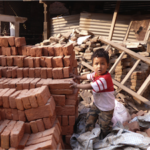
The Kid
I spend time with kids whose playground consists of an abandoned cement mixer, a temple and this pile of bricks.
There is an old couple sitting by the temple but no sign of any disapproving adults telling them it’s forbidden to run and hide amongst a holy place, or in a building site. I love the way that kids are left free to play outside, without the excessive control and monitoring that seems to have taken over our culture (along with 24 hour news scares and the normalisation of paranoia).
Ganesh
This is Ganesh, one of the most popular Hindu gods. I find him on the side of a building in the Patan district of Kathmandu. It may be hundreds of years old. You may be wondering why it’s covered in red and yellow paint and, to tell you the truth, I’m not quite sure as I know almost nothing about the Hindu religion. But I do know that Hinduism is more than a religion as we know it, it’s more like a cosmology with a whole pantheon of Gods, each with their own legends, followers, temples and rituals. It has been going for thousands of years and seems to be flexible enough to rub alongside other religions and exist quite happily within the modern world.
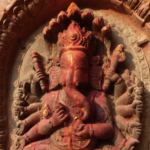
To answer my own question — why is Ganesh covered in paint? — I think the answer is that this little chap is part of the community. People come out of their houses early in the morning and carry out ancient rituals which involve chants, prayers and paint. It shows that he is being used on a daily basis by lots of people, not like the statues in our churches, which nobody but a kid would touch. I need to go out in the morning, in Anthropologist Mode, and observe the people at worship. I love this way of life, I love the daily connection with God and the fact that this spirituality is so ordinary and just another part of life. I remember the Buddhist monks in Tibet used to have fun, make jokes and have a much more light approach to life when compared to the serious western intellectuals who would come and visit them.
I looked up my elephant friend on Wikipedia and it says Ganesh is:
one of the best-known and most worshipped deities in the Hindu pantheon…Devotion to Ganesha is widely diffused and extends to Jains and Buddhists…Ganesha is widely revered as the remover of obstacles, the patron of arts and sciences and the deva of intellect and wisdom. As the god of beginnings, he is honoured at the start of rituals and ceremonies. Ganesha is also invoked as patron of letters and learning during writing sessions.
The Deity
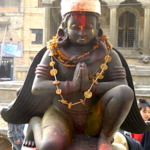
I’m not sure who this deity is but he (or is it a she?) surprised me. I stumble across yet another little pagoda and am taking a photo of its door when I notice a big person, right behind me, in a large mirror that was hanging above the door. I glance round and see this life-sized statue and wonder how I had missed it? Does it have the power of invisibility? The real answer is that there is so much to take in at each little temple (ornate wood carvings on the buttresses, a forest of murals, a small stone ox facing the main door, candles and incense burning, doors facing each direction, flowers, carvings) and so it’s easy to miss things. I presume that local people would know who each God is and what they represent. Notice the fresh paint splashed on its forehead and the home-made necklace that has been thrown over its neck — all indications that it is part of the local people’s daily life.
To me, this deity represents the cultural richness that is contained in the ordinary backstreets of Kathmandu, or at least in the area where I’m staying — Patan — where you just have to wander in any direction to come across gems like this. Walking around here is like wandering into a fairy tale, a mystery set in ancient times, where I don’t know what’s going to happen next.
The Poster
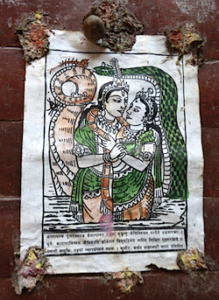
I have no idea what this poster says or represents but I can tell you that it is fairly small (about A4 size) and is printed on home-made paper. It certainly looks intriguing, perhaps it’s a love story from the Bhagavad Gita, the Hindu equivalent of the Bible? I love the sealing wax material they use to attach it to the wall. The whole effort suggests home-made, local, done with love and devotion rather than the mass produced communications that we in the west are surrounded by.
Nepali Budgie
When I was last in Nepal the only way to communicate with home was to queue up at the Post Office and send a letter. We would then ask at the “Poste Restante” desk if anything had been sent to us (my temporary address was Post Restante Kathmandu). Now the Ncell mobile service is everywhere in town and getting online is cheap.
I call my daughter from the yard in front of my brother’s house (he lives here as a disaster relief coordinator, more on him later) in Patan. I call her on WhatsApp and we chat normally, as if I’m up the road and not 9,000 kilometres away. I’m not sure how to describe the streetlife of Kathmandu and the words that come out of my mouth all seem insufficient: “amazing…crazy…chaotic…inspiring.” She thinks I’m a hippy.
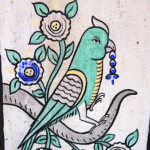
She asks me what her uncle Moona’s front door is like. This gives me a focal point and I go over and photograph it, noticing for the first time that it is surrounded by hand-painted symbols — including this rather defiant looking budgie.
There is so much to see here that I tend to miss things. I can only take in a certain amount of visual stimulation and in Kathmandu it’s like being in a museum, a video game and a crowded street all at the same time.
- 1917 (2019) - 11th January 2020
- The Shakespeare Soap Opera - 10th June 2016
- On the Road with Madame Bovary - 4th April 2016











The 2nd “God” isn’t necessarily a God. That is “Garuda”, servant to Vishnu (and his means of commute..Garuda is, to borrow a term from Harry Potter, an animagus capable of turning into a hawk at will).
The “poster” depicts a “Naga” (literally, serpent) couple. On the festival of Naga Panchami, it is tradition to place Naga figures on one’s doorstep to prevent bad luck from entering the premises. Nagas (or their images) are belived to have the power to do so.
Thanks a lot for this very interesting reply. Can you recommend a book that explains the Hindu pantheon? I don’t want to read the whole Bhagavad Ghita but there must be something short and easily digestible to read? Ciao